In this article, you will learn the different parts of car wheel assembly and their functions. All explained with Pictures.
If you need a PDF file, download it at the end of the article.
What is the Function of a Car Wheel?
Every type of vehicle, from small cars to large trucks, depends on the simplest mechanism to operate: its wheel. Recently, cars have been modified into various bodies, designs, and sizes. Some auto parts are now ancient and have expired or been replaced with new versions.
The wheel is just a circular part intended to rotate on the axle bearing. Wheels, in conjunction with axles, allow heavy objects to be moved easily, reducing movement or transportation while supporting loads or performing labor in machines.
These wheels generate rotary motion and are liable for moving the car from one place to another. Without wheels and tires, cars and trucks would be little more than expensive lawn ornaments.
There are numerous parts of a wheel, each of which has a specific function, but not every driver is familiar with all of them. To give you a brief overview of these parts, we’ll explore the basic parts of a car wheel and tire below.
So, let’s get started.
Read Also: What are the Main Parts of a Car Engine? Its Function
Parts of Car Wheel
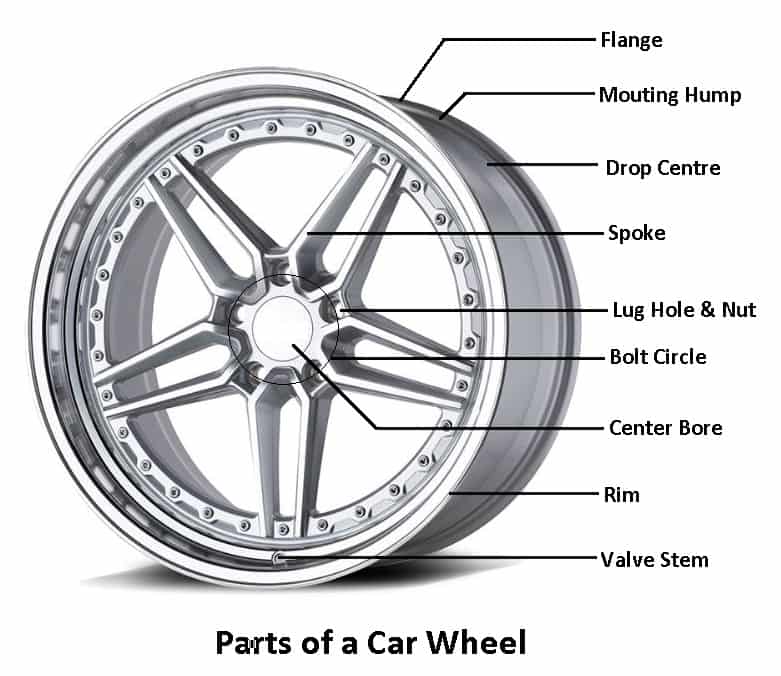
The following are the main parts of car wheel:
- Wheel bearing
- Wheel rims
- Tire
- Wheel hub
- Wheel fasteners
- Barrel
- Bolt circle
- Outer lip
- Flanges
- Centre bore
- Valve system
- Spoke
- Center cap
- Beads
- Lug hole
Related Article: 25 Car Dashboard Lights and Their Meaning [Explained]
#1 Wheel Bearings
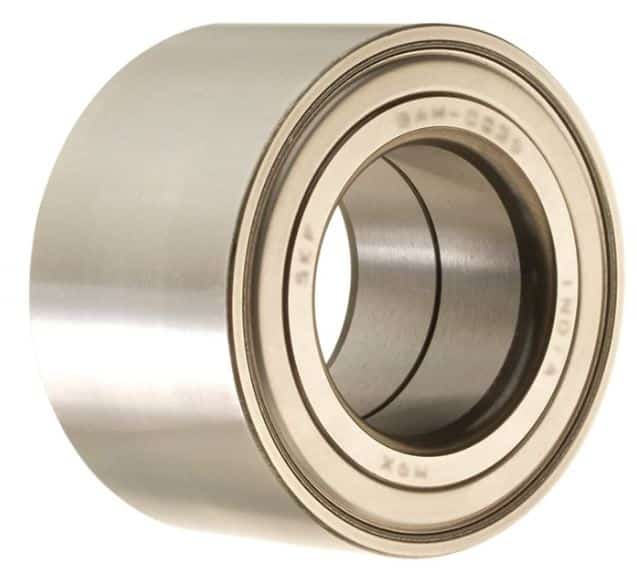
Antifriction bearings are commonly used as wheel bearings. They create a low-friction connection between the rotating wheels and the stationary vehicle. This type of bearings consists of three basic parts, which are the inner race, rolling element, and outer race.
The main purpose of using wheel bearings is that they enable the wheels to rotate smoothly with minimum friction. Car wheels have hubs in the center where the wheel bearings fit tightly within the hub and ride on a metal axle shaft, which helps reduce friction when the wheels spin.
When choosing a wheel bearing, it must be carefully selected considering the type of load, maximum bearing speed, and where the bearing will be used on the vehicle.
#2 Wheel Rims
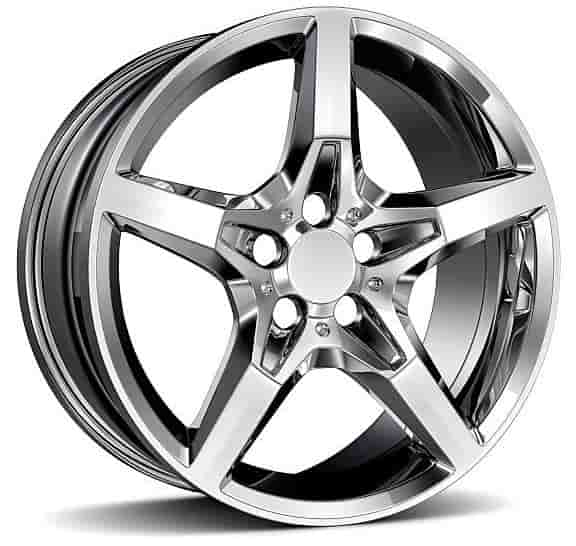
Rims are the essential parts of a car wheel that act as the outer edge of the wheel, holding the tire to the wheel. The main function of the rim is to support and seal the tire to the wheel to ensure proper fitting between the tire and the rim.
It is usually made of steel and installed on the rim, and the rim is bolted to the hub. Steel rims are significantly lighter in weight and reduce the amount of unsprung weight. Modern vehicles increasingly use rims made from materials such as aluminum, aluminum-magnesium alloy, and graphite, known as custom rims.
Customized rims give your car’s wheels a colorful and unique style, but they come with an additional cost.
#3 Tire
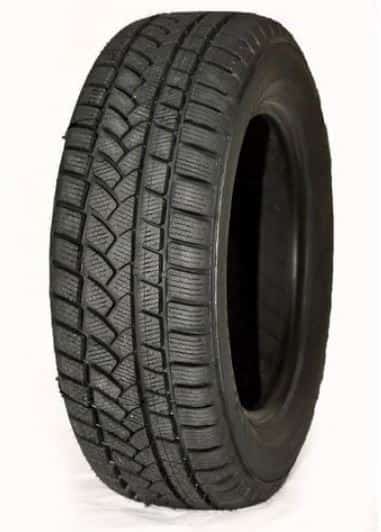
As everyone knows, tires are made to support the vehicle’s weight, absorb road shock, transmit traction, torque, and braking forces to the road surface, and maintain the direction of travel. Tires are made of flexible rubber and filled with compressed air to perform these functions.
They can be considered part of the suspension system. Tires are covers that prevent wheel rims from rubbing or touching the ground. The main parts of a tire are the threads that contact the ground directly and wear out over time.
Threads usually have grooves and notches known as patterns. The purpose of this pattern is to increase the friction between the ground surface and the tire and to direct water and debris away from the wheel.
#4 Wheel Hub
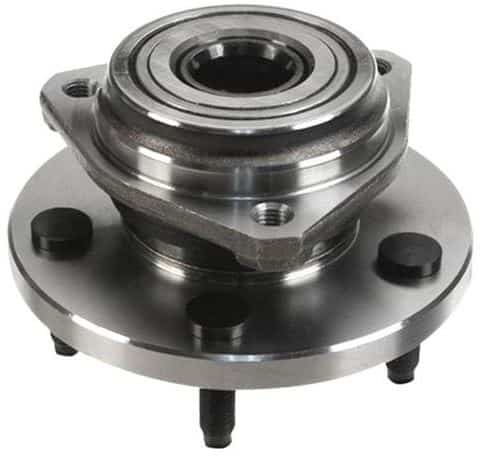
The wheel hub assembly keeps the car wheels attached to the vehicle and allows the wheels to spin freely so the driver can safely drive. In addition, it is also important for anti-lock braking systems (ABS) and traction control systems (TCS).
It is located in the center of the wheel to which the rim is attached and houses the brake pads, calipers, and rotors. The tires are attached to the hub, and five bolts are held in place with a lug nut from its center.
#5 Wheel Fasteners
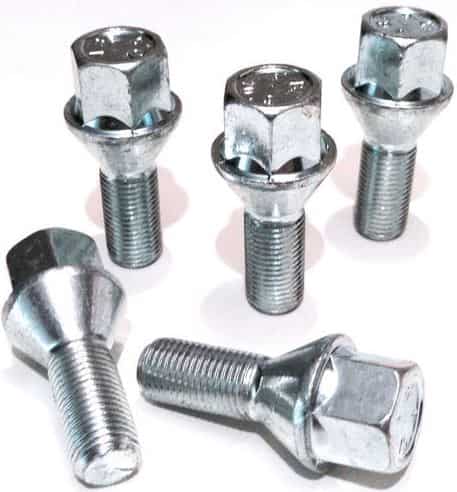
A fundamental factor in the wheel and tire design is how the rim is mounted on the hub or axle flange. The wheel studs are used as wheel fasteners in the hub or axle flange on every type of vehicle. These are probably threaded bolts or studs pressed into a hub or flange for a tighter joint.
Typically, the head of the stud is wider than the hole in the hub or flange, preventing the stud from coming through the hole. To center the wheel appropriately, the center of the hub or flange is raised slightly and positioned at the rim’s center.
Read Also: 20 Basic Parts of Car Interior [Name & Functions] PDF
#6 Barrel
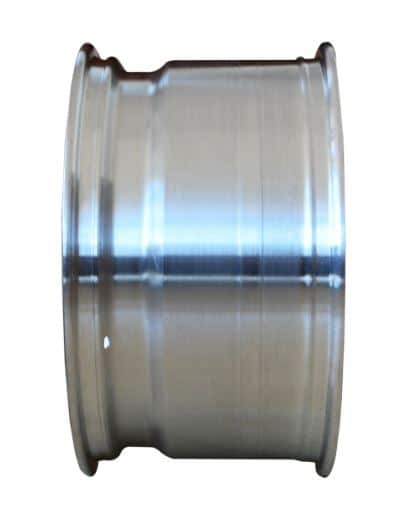
The part of the car wheel between the outboard face and the inboard rim edge is known as the barrel. The purpose of the barrel is to create a surface for the mounting of the tire. The inner diameter of the barrel is the drop center that helps to determine the mount wheel type.
In the case of front-wheel drive vehicles, the drop center is near the front of the wheel. On the other hand, in a rear-wheel-drive vehicle, there are drop centers near the rear of the wheel. The sides of the barrel are shaped to form flanges, which ensure that the tires do not slip while the car is moving.
#7 Bolt Circle
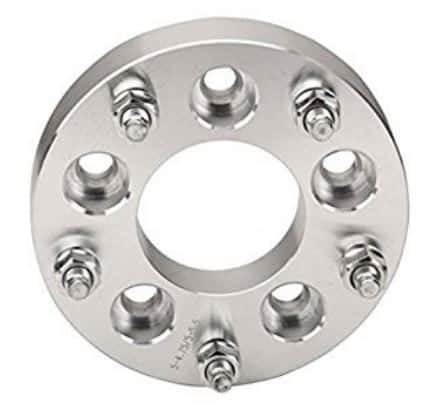
A wheel’s bolt pattern may also be called bolt circle or pitch circle diameter. This is the area created by the lug bolt. The bolt circle is expressed as the number of lugs by the diameter of the imaginary circle formed by the center of the lugs.
For example, 5 lug bolt holes and a 4-inch BCD would be a 5×4″ bolt pattern. Bolt circle generally varies between the wheel and car manufacturers and makes it difficult to cross-fit wheels designed for different car manufacturers.
#8 Outer Lips
The outer lip refers to the part that will most likely collapse when a wheel hits the pothole and is the most repairable area. Technically, the lip can be bigger or deeper until it meets the face of the wheel.
A deeper outer lip is easier to damage by the impact because the spokes cannot provide as much support. The outer lip is on the outside and is measured from the face of the wheel to the edge.
#9 Flanges
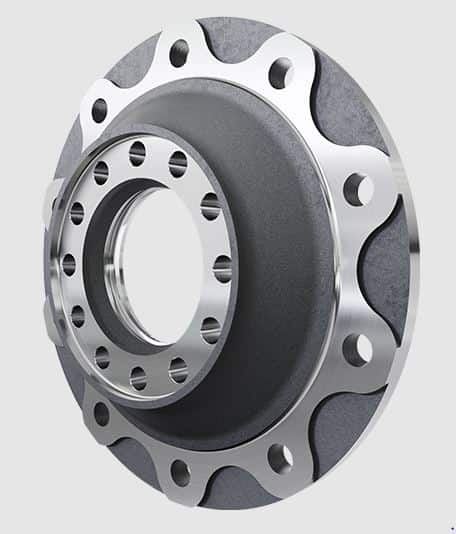
Typically, a wheel flange serves as a connector that allows the vehicle’s wheels to be attached to the axle. These are mechanically locked to either the drive axle or to the end of the spindle. In addition, they are on the sides of the wheel designed to prevent the tire from slipping unnecessarily.
Wheel flanges with lug nuts have long been the standard mounting procedure for car wheels. The flanges are located on both ends of the wheel and will keep the tire held onto the wheel even in extreme conditions or uneven road surfaces.
Read Also: What is the function of the crankshaft position sensor in your car?
#10 Center Bore
It is the machined opening in the center of the wheel that properly centers the wheel on a vehicle. A wheel needs to be hub-centric to reduce the chances of vibration. This is usually an empty area containing the functional space that goes over the axle and supports the car’s weight.
If the diameter of the hub collar is larger than the central bore, it will be impossible to fit the new wheels. Similarly, if the center bore is larger than the diameter of the hub, the wheel can be fitted, but an unwanted diameter difference would be difficult.
#11 Valve System
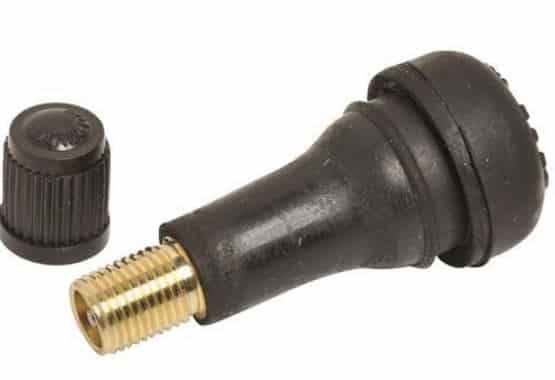
Almost every vehicle tire inflates or deflates through its valve system. The function of the valve is to keep air or nitrogen in, preventing it from escaping. Therefore, it is an important element in maintaining tire pressure and driving safely.
Typically, wheels have two valve stems for two reasons. The first is to pump in the air with a valve stem, and the second is to refill nitrogen air. Simply put, one valve stem pumps nitrogen while another purifies regular air.
#12 Spokes
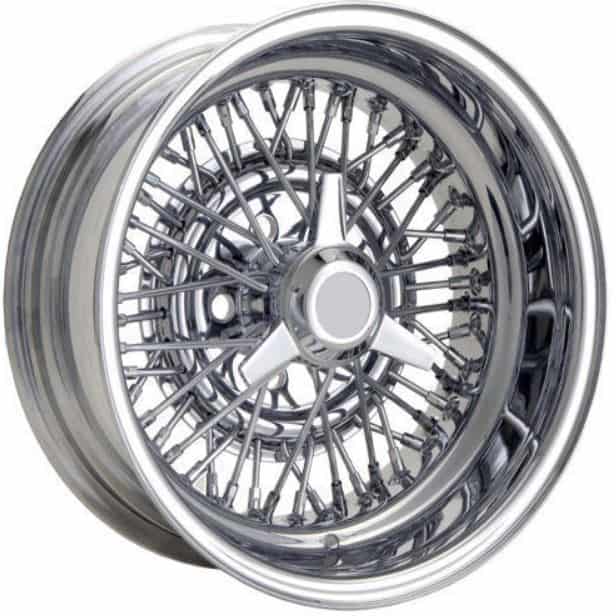
The spokes play an important role in connecting the wheel’s rim to the plate at the center of the wheel. The lugs and bolt holes that secure the wheel to the car are kept here. The spokes also shield the outer edge and prevent damage from minor impacts.
These spokes are available in thousands of designs. There are 5 spokes in the classic style, but there are also some that have intricate designs or as few as 3 spokes. The stability and strength of spokes vary depending on the material and design.
Read Also: Types of Car Jacks & Their Uses [PDF]
#13 Center Cap
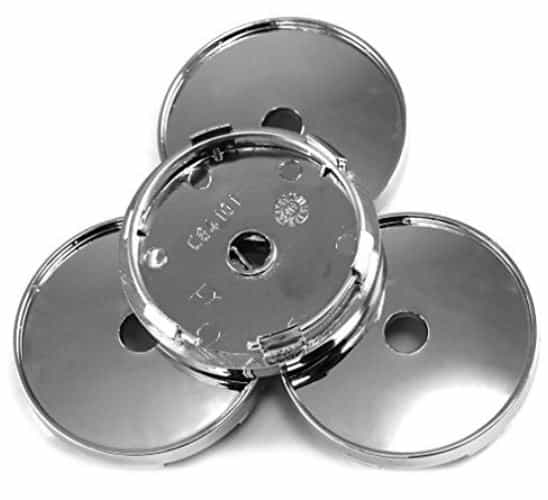
Good quality car wheel center caps ensure that the wheel rims and tires of the vehicle are protected from dirt and sunlight. These car wheel caps are a great investment, particularly for drivers who leave their cars parked in public areas.
The center cap is at the center of the wheel where the spokes are. In some models, the center cap can be removed. However, most wheel rims do not have a removable center cap. A wheel can still be fully functional without a center cap, making it look more uniform and complete.
#14 Beads
The main purpose of tire beads is to firmly attach the tire to the outer surface of the wheel. This is done by using the pressure of the wires to mold the rubber firmly into the wheel’s frame. Beads are also part of the wheel that will transfer energy.
If the beads are damaged, the energy can transfer awkwardly and cause the entire vehicle to shake, especially at high speeds. Beads are important because they create an airtight seal against the wheel and allow for a more efficient transfer of forces as the car is moving.
#15 Lug Hole and Nut
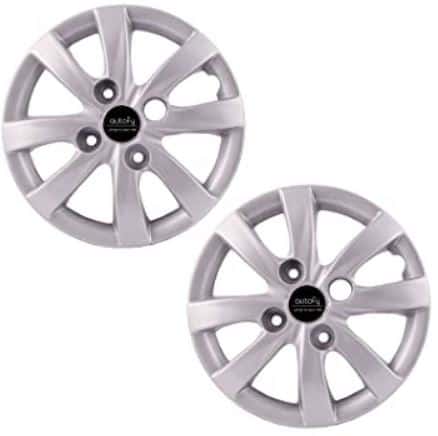
The lug hole is usually machined to form a bolt circle on the center disc. These are the holes into which the lug nut is bolted. Lug holes are usually empty spaces covered by the center cap. The lug holes form a bolt circle with a diameter called the bolt circle diameter.
The lug nut fits into the lug hole to fasten the wheel hub to the threaded wheel stud on the vehicle’s axle, securing the wheel and centering it properly on the axle. It is a nut fastener with a round or conical (tapered) end.
Read Also: Differential: 9 Types of Differentials & How They Work?
Conclusion
As we said, the car parts that have always been in use are the wheels. These circular systems generate rotary motion and are mainly responsible for moving the car from one point to another. Hence, wheels are an essential part of any automobile.
Now, I hope I’ve covered everything you were looking for about “Parts of Car Wheel.” If you still have any doubts or questions regarding this topic, leave a comment below I’ll reply. If you like it, then share this with your friends.
Want free PDFs direct to your inbox? Then subscribe to our newsletter.
Download PDF of this article:
You might like to read more in our blog:
- 10 Different Types of Transmission Systems and their functions [PDF]
- What are Engine Valves? Types & Mechanism [Explained]
- What is Intake & Exhaust Manifold? [PDF]
- Understand The Working of Single Cylinder Engine
- Everything You Should Know About The Manual Transmission
- What problems can a worn-out braking system cause? [remedies explained]
- The Working Principle of a Wankel Rotary Engine [Pros & Cons]
- What is Propeller Shaft? And how it works?
Frequently Asked Questions
Wheels are parts that help to lessen frictional force. When you turn the steering wheel, the wheels of your car move in a different direction. This makes it possible for your car to travel in the desired direction. When your vehicle’s path changes, the tires keep it stable.
The basic parts are: #1 wheel rim, #2 Wheel bearing, #3 Wheel rims, #4 Tire, #5 Wheel hub, #6 Wheel fasteners, #7 Barrel, #8 Bolt circle, #9 Outer lip, and more.
Please can explain more about the car sensor???
Sure, car sensors are devices that monitor various aspects of a vehicle’s performance, like speed, temperature, or tire pressure. They provide data to the car’s computer system for better control and diagnostics. You can also checkout our article, we have written about car sensors in detail.
This is a great article! I have been working on repairing car wheels for years and this is the best information I have seen.
Thank you for the kind words!
This is a great article! I have been working on repairing car wheels for years and this is the best information I have seen.
I’m glad it was helpful for you.
That’s fantastic and informative.
You’re welcome.